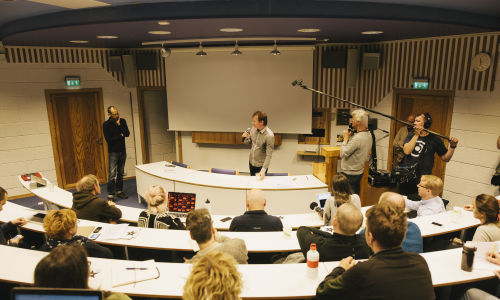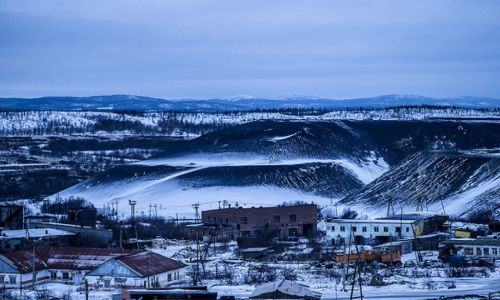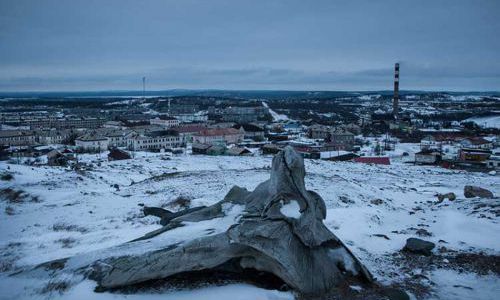Mapping Hybrid Ecology – Encounters In a Layered Landscape
Antti Tenetz
This is an exploration of the landscape around Kilpisjärvi lake. Part of the focus is to find and study the layers of Hybrid ecology; where biological, technological and cultural layers are coexisting and influencing each other in the landscape. Our team is set out on several days of fieldwork in the surroundings. Each group member is uncovering layers of the landscape through their own perspective and practice, exploring the sonic, political, microbial, visual, and invisible aspects of the layers.

On the first day, the group's host Antti Tenetz guides us on a walk through sites that show traces of human influence in what we would normally perceive as pristine nature. We start at the site with debris of German barracks from WW2. From there on as the group climbed up the slope of Saana fjell, we crossed a border of habitats, from the arctic to the alpine.
In the alpine biome above the tree-line, the metabolism of vegetation is so slow that a WW2 Junker's air-plane crash site remains clearly visible almost 80 years after the event. The black scarred soil looks almost as fresh as if it happened weeks ago. Sifting through the molten pieces of aluminium and steel raised ethical questions about taking samples home. Somehow they seem to have blended in with the natural surroundings, merging artificial and biological layers into a hybrid site.
Anssi the composer in our group was immediately drawn to this site. All physical objects have their own sonic resonant frequency, which is attributed to the size and volumetric mass density of the object. This would make the Junker's site an ideal spot for recording percussive metallic sounds of different pitch and tone.
Anssi recorded over 90 different audio samples from various fragments of aluminium and steel on the site. The samples were later processed to become one of the sonic layers of the interactive sound art installation that he exhibited at the Biological station on the last day of our visit there.
Our explorations in the land were enriched by a discussion on broad interpretation of mapping including local oral traditions. We talked about mapping practices and motivations behind mapping, both for our own artistic work and historically. In his presentation at the biological station, Antti showed us the Olaus Magnus' Carta Magnus (AD1529), describing it as a martially and politically motivated economical map of Scandinavia. A map as a hybrid geography overlaying actual locations of the time, with highly subjective and even mythical layers. With this beautiful example Antti guided our discussion towards the subjective scaling and data selection process inherent in map-making; what to present and how does that relate to the background it is presented on. We also discussed the invisible layers in the landscape.
Representing invisible layers of Hybrid ecology were the two very high frequency antenna field arrays we visited. The KAIRA (Kilpisjärvi Atmospheric Imaging Receiver Array) site is like a small neighbourhood of mysterious rectangular structures beyond a wire fence, physical access tantalizingly forbidden (but breached by Antti's overhead drone photography). We also explored the still-in-use older precedent of KAIRA, just down the road, a field of dozens of antenna poles one can wander freely amongst, under a canopy of guy-lines somewhat resembling an overdesigned clothesline.
Due to standing interests in electromagnetic activity of all kinds, Peter was particularly attracted to the two VHF antenna arrays. KAIRA studies the ionsphere from the ground, receiving "incoherent scatter" radar beams sent by a sister station in Tromsø, bounced off electron fields in the upper atmosphere. The idea of using a "randomly perturbed" field to indirectly coax valuable information from something distant and nearly inaccessible while remaining grounded is an apt metaphor for many research methodologies in the arts and incoherent scatter ought to be co-opted as buzzword/ personal mantra.
Peter also created a makeshift loop antenna from a reindeer antler and copper wire. One windy afternoon he and Maia climbed to the top of Saana fjell and used the "Antlenna" to record electromagnetic waves.
Our group visited the three country cairn, where Finland, Sweden and Norway meet. On our hike to the cairn we could see a fence, built to stop the movement of reindeer, from Finland to Norway and Sweden.
Maia became interested in the border and how that single line causes the cultural, political and biological realms to meet, interact, clash, and change. In the Arctic the knowledge of the traditional reindeer herding Sami culture gave her a clear insight of how the borders have influenced people's cultures and the ecosystem.
Maia interviewed Oula, a Sami reindeer herder, who said “reindeer is a very high tech animal.” Oula explained that traditionally in the summer reindeer moved to the North, to the sea, where there are less insects and the vegetation is rich in nutrition. In the winter they moved to the warmer south where they fed on pine trees. Both the reindeer and the ecosystem's health depended on this large movement. Sami people had started following the reindeer and were dependent on them for survival. Oula recounted some of the political events from the last 200 years and how they led to the establishment of more firm country borders which restricted the Sami and consequently the movement of the reindeer. After leaving Kilpisjärvi, Maia edited Field Notes: Borders a video with people's interviews and a watercolour animation that illustrates her findings. (link of video coming soon)
Piibe's personal inquiry had quite narrow shift - to take water samples from different water bodies and to explore them later in the lab with a microscope. She had planned to study the arctic waters, since they would be an interesting addition to the studies she had done before. The microorganisms could also be seen as one of the invisible biological layers of an area. She collected the water samples from creeks and marsh pools, by putting them in water bottles and exploring them more precisely later.
When she returned to Tallinn and went to the Lab of TUT Marine Institute (Estonia) to explore Kilpisjärvi waters, she got to know that there has been very long and thorough research done by Estonian scientists about Kilpisjärvi waters recently. Piibe met one of the scientists that participated in the project and had the great opportunity to share her fresh memories, pictures and feelings with her, since the scientist did her work without being in Kilpisjärvi herself.
Theun mapped the landscape linguistically into several categories starting with Actions through which the landscape and organism expresses itself, then moving into Textures, Shapes, Viewpoints and finally into Realms. The process made it clear how crucial it was to have local knowledge such as Antti's in the mapping process. Without that the mapping would remain superficial. This list of words was recorded by Peter and became an _abstract geographic poem_ https://soundcloud.com/encounters-175905074/theun-list-kota describing the Kilpisjärvi area.
When our group sat down to discuss the possibility of artistic collaboration based on what they had experienced in the Arctic, Theun shared his list of words about the landscape. The list was a point of departure for Lori to use her LEDs to light paint Theun's words into the landscape. Theun's list of words was converted into handwritten digital images in order to play across the LED array that Lori uses in her practice. The next day, Peter and Lori took off for the sauna, hoping that the sauna's porch would protect the technology from weather, while also being able to photograph in the landscape. When the misty morning turned out to be too bright for the LEDs, they moved to the kota.
Using the pine-paneled interior of the hut was a great backdrop to light-paint the text across. Over the next few hours, Lori, Theun and Peter took turns using the LEDs to draw all of the 307 text files across the kota, which resulted in photographs where the people disappear and the words are left floating across the space. The group plans to continue collaborating in order to combine the images and audio into a video piece that might also include other layers of content from our group.
This blog post is a reflection on Field_Notes - HYBRID MATTERs that took place on 14.-20. September 2015.
Field_Notes – HYBRID MATTERs is an art&science field laboratory organized by the Finnish Society of Bioart at the Kilpisjärvi Biological Station in Lapland, Finland. The project is in search of artistic and scientific responses to converging ecologies. The local sub-Arctic ecology and environment, as well as the scientific research and infrastructure of the Kilpisjärvi Biological Station will act as fields and catalyst for the work carried out.

Photos: The group
From upper left corner: 1. The crash site. 2. Potentially resonant object? 3. "Carta Marina" by Olaus Magnus. 4. Peter at the older antenna array. 5. Piibe taking water sample from a stream 6. When the misty morning turned out to be too bright for the LEDs, they moved to the kota.

Watercolour study of the hike to the three country cairn by Maia Iotzova
The team
Antti Tenetz (group host)
Antti Tenetz is intermedia artist, adventurer and naturalist. Tenetz’s works are situated on the interface between media arts, bio arts and urban art. In his works he combines and fearlessly uses different forms of expression, media and technological platforms from stone age hunting systems to satellite tracking. He concentrates on studying the relationship between man and nature, with themes changing from the Siberian bear cult to the digital representation of animal sensory systems. Tenetz focus is on multi-disciplinary and multi-artistic cooperation between art and science. He has co-funded and worked with international artist groups such as Subzero, and Grafting Parlour and recently in The Finnish Society of Bioart. Tenetz’s works and collaborative projects have exhibited in Finland and internationally. His work was shown at the Venice Biennale 2013, X-Border 2013, Pan-Barentz 2009. http://www.tenetz.com
Peter Flemming
Peter Flemming is a Canadian artist based in Montréal working mainly in installation and performance. His research interests include incident energy reclamation, solar powered lazy machines, and designs for open-source hardware. Current projects involve improvisational and intuitive building, resonance and electromagnetically activated materials, and modular neuromime networks. Exhibiting extensively at galleries, festivals and museums both nationally and internationally, Flemming has garnered numerous grants and awards to support both his research and creative practice. He serves as Vice President of Oboro in Montréal and is also an occasional curator and writer. Flemming has taught experimental electronics internationally and is a professor in studio arts at Concordia University. http://www.peterflemming.ca
Lori Hepner
Lori Hepner is an interdisciplinary artist working primarily in conceptually based photography, Arduino/LED device artworks, and social media art. A recent body of work, Status Symbols, is a series of portraits that are studies of identity in the digital age of social media. The portraits focus on visualizing text-based tweets into abstracted visual portraits by using the on/off signature of the computer’s native language, binary code. #Crowdsourced #Landscapes: Beyond the North Wind, her current project, creates experimental landscapes surrounding personal landscape, memory, and climate change. Lori is associate professor of integrative arts at Penn State University’s Greater Allegheny campus in Pittsburgh, PA. http://www.lorihepner.com
Maia Iotzova
Maia Iotzova is a filmmaker and a media artist who grew up in Sofia, Bulgaria and is now based in Montreal, Canada. She completed a BA in Fine Arts at the University of Guelph in Canada. Maia's work explores our relationship with nature in the urban setting. She often looks at a subject from an intercultural perspective. She mixes traditional documentary film with experimental cinema and subverts traditional mapping techniques to explore our subjective connection to the landscape. In 2014 she formed the Wild City Mapping Collective to create an open source based on-line map of the wild green spaces in Montreal. http://www.wildcitymapping.org
Theun Karelse
Theun Karelse studied art at the Sandberg Institute in Amsterdam before joining FoAM a translocal platform for artistic research. Currently Theun leads the MidWest Experimental Station which features experiments and artistic expressions related to horticulture, urban ecology and restoration ecology. He initiated Machine Wilderness, a program investigating technology aimed at participating holistically in natural cycles and foodwebs. http://theunkarelse.net
Anssi Laiho
Anssi Laiho is a sound artist/ electronic music composer. For the last 10 years he has established himself as a freelance sound artist. In his acousmatic works Laiho creates constantly evolving sound structures that require the full attention of the listener. Main emphasis of these works is on psycho-acoustics, musical structure and the theoretical concept behind a piece of art.
In his works for theatre, Laiho uses live-electronics in order to create real life live event. In these works Laiho’s emphasis is on the social function of a performer as a interpreter of an message envisioned for the audience by the composer.
Piibe Piirma
Piibe Piirma is media artist, curator and teacher based in Tallinn, Estonia. She was initiator and main organizer of conference 'Art&Science - Hybrid Art and interdisciplinary Research' and exhibition 'Rhizope' (2014, Estonian Academy of Arts). She has worked as designer and visual artist since 2002 and curated several new media art exhibitions since 2006. Piibe’s current activities are related with PhD studies at EAA since 2009, the title of the thesis is 'Hybrid Practice. Art and Science in Artistic Research'. http://www.piibepiirma.com
Further reading on the topic
Field_Notes – HYBRID MATTERs https://fieldnotes.hybridmatters.net
Finnish Society of Bioart http://bioartsociety.fi/
KAIRA-antenna array http://kaira.sgo.fi/p/about.html
Green Dream http://www.greendreamfilm.com
Wild City Mapping http://www.wildcitymapping.org
Machine Wilderness http://fo.am/machinewilderness
Sonic Layers http://soundcloud.com/anssi-laiho/sets/field_notes-hybrid-matters-2015
Research by Estonian scientists about Kilpisjärvi http://www.researchgate.net/publication/280931237_Factors_affecting_the_chemical_composition_of_snowpack_in_the_Kilpisjrvi_area_of_North_Scandinavia
From the Book
-
Dark Ecological Chocolate
Timothy Morton
Dark ecology starts off dark as in depressing. Then it becomes dark as in mysterious. Then it ends dark as in sweet dark chocolate. In this lecture I'm going to provide an experiential map of dark...
-
Nikel — The City as a Material
An interview with Tatjana Gorbachewskaja
Tatjana Gorbachewskaja is an architect who grew up in the Russian town Nikel, located in the far North near the Russian border with Norway. For Dark Ecology Project she researched the materials of...
-
What Is Dark Ecology?
Timothy Morton
In this essay, which draws on his book Dark Ecology, For a Logic of Coexistence, Timothy Morton — who originally coined the term dark ecology — explains what dark ecology is. He also argues how...


